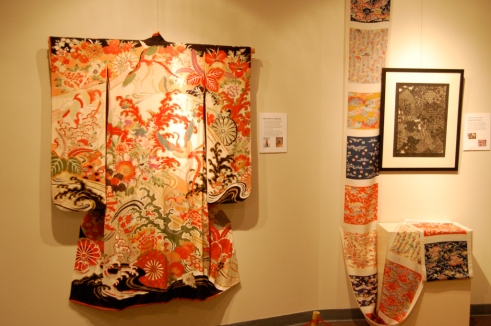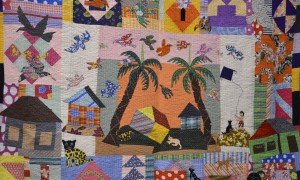To wear a kimono is to make statement. While saying something like this is a bit of a cliche in the world of fashionistas I recently learned it is true when I attended a wonderful exhibit called Artfully Adorned: The Japanese Kimono. The exhibit is at the Saugatuck Center for the Arts in Saugatuck, Michigan. It is part of a month (April 2010) long festival focusing on Japan.
Amazingly, a kimono can communicate age, gender, occasion, season, formality, status and wealth of the wearer. For example, longer sleeves are worn by younger women, shorter by more elderly. Younger women can wear bright colors whereas pale colors are appropriate for more senior females.
The stunning garments have been part of Japanese culture since the 700’s reaching their peak of popularity in the 1700’s. We’re all familiar with the lovely gowns traditional Japanese women wear making them look some times like sausages wrapped in baby’s swaddling clothes. Beautiful to look at, yes, but it has to be challenging to move around in one.
In fact, a kimono has been described as a combination of a straight jacket and a hobble skirt. While difficult for Westerners to imagine wearing, the fabrics, embroidery and weaving are true works of art. In fact, I think many are more beautiful hung like the ones in this exhibit than on the body.
The kimonos on exhibit are from the collection of Etta Hesselink, who lived in Japan for twenty years and became fascinated with the traditional Japanese garb when a Japanese friend introduced her to their intricate construction.
Here are the highlights of a recent talk on kimonos given by the collector at the Center.
- Young women will spend between $2,000 to $20,000 for a kimono, often buying them on time the way we might get a mortgage.
- A kimono is almost impossible to put on all by yourself.
- Since a kimono has no form of it’s own, it is typically stored folded on its seams, in a small space. They are created from flat pieces of fabric, 14 inches wide. Typically a kimono will take 12.5 yards of fabric.
- Until the 17th century, the Obi—the part that ties around the middle of the body, was tied in the front, making activity almost impossible.
- A kimono reflects a rigidly controlled Japanese culture that is intolerant of experimentation but values beauty.
- There are Kimono Academies where young women learn the art of wearing a kimono and all of the symbolism.
- A pure white kimono is reserved for the dead.
- The images in a kimono are often symbolic. For example, the mandarin duck is a symbol of marital fidelity
For more information about the exhibit, visit the web site for the Saugatuck Center for the Arts. www.sc4a.org









Comments
1 CommentArt Institute in Chicago Features Kimonos | DesignDestinations
Oct 16, 2011[…] To read about a Kimono exhibit in Saugatuck, Mi, click here. […]